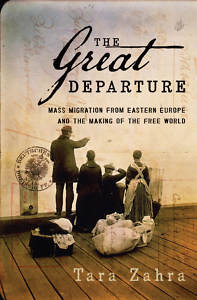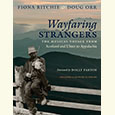Europe’s Exodus
Tara Zahra’s The Great Departure gives a sweeping history of European migration to the U.S.
It is rare for a young historian to receive a MacArthur Fellowship—widely known as a “genius grant”—but Tara Zahra is a rare young historian. Her latest book, The Great Departure, examines the experiences and meanings of the mass European migration to the United States in the late-nineteenth and early-twentieth centuries, reorienting our understanding of this phenomenon on both sides of the Atlantic.
 Zahra is a professor of history at the University of Chicago. Her other books include The Lost Children: Reconstructing Europe’s Families after World War II (2011) and Kidnapped Souls: National Indifference and the Battle for Children in the Bohemian Lands (2008). She answered questions via email from Chapter 16:
Zahra is a professor of history at the University of Chicago. Her other books include The Lost Children: Reconstructing Europe’s Families after World War II (2011) and Kidnapped Souls: National Indifference and the Battle for Children in the Bohemian Lands (2008). She answered questions via email from Chapter 16:
Chapter 16: The mass migration from Eastern and Central Europe in the late-nineteenth and early-twentieth centuries is part of the American myth—the “huddled masses” escaping repression and flourishing in a land of opportunity. How does your book complicate that myth?
Tara Zahra: Migrants themselves complicated and challenged the myth of the American Dream in their words and actions. Many people today are surprised to learn that around thirty to forty percent of immigrants to the United States during the Great Migration eventually returned home to Europe. Some of them always planned to return home, but many were disappointed with what they found in the “Golden Land.” Migrants often came to the United States and found themselves working brutally long hours in abysmal conditions; they were homesick; they became impoverished, ill, or injured, and there was little social support. Americans tend to remember only the success stories, particularly if their own ancestors came and stayed. That’s only part of the story.
Chapter 16: Were these emigrants “white”? What does that even mean?
Zahra: The history of mass migration in this period is also a history of how the definition of “whiteness” itself changed over time. European governments, including those in Central, Eastern, and Southern Europe, certainly considered their citizens to be “white.” Officials and social reformers in countries that were exporting people worried that migrants who emigrated to North or South America would be treated no better than African-American plantation workers, Chinese coolies, or other colonial laborers. This was one reason that these governments increasingly sought to restrict emigration. In the United States, at the same time, nativists who opposed immigration were increasingly questioning the “whiteness” of migrants from Southern and Eastern Europe. They insisted that the U.S. needed to restrict immigration in order to protect the “racial stock” or “whiteness” of the U.S. population.
Chapter 16: In a chapter called “The First Final Solution,” you highlight a series of Jewish resettlement plans in the late 1930s to locales such as Guiana, Angola, Madagascar, and the Dominican Republic. What do these political responses to the “Jewish problem” show us?
Zahra: They show us that in the 1930s there was a broad consensus—among East European anti-Semitic governments, the Nazi regime, Zionists, and many Western governments and humanitarian organizations—that Jews needed to be “relocated” someplace outside of Europe. There was a disturbing overlap between anti-Semitic fantasies of expelling Jews and humanitarian or Zionist attempts to rescue and resettle Jews, even though their underlying politics and goals were very different.
There was also overlap between anti-Semitic plans to remove Jews from Europe and European colonial ambitions. The territories proposed for Jewish resettlement were often imagined as “empty” lands that would benefit from Jewish “civilization.” These discussions ultimately help explain why so few people protested when Hitler began to remove Jews from European cities under the pretext of “resettling” them in the East.
 Chapter 16: The Cold War highlighted the politics of migration across borders—the Berlin Wall seems the most obvious example. Yet you caution against a simple equation of freedom with mobility. Why?
Chapter 16: The Cold War highlighted the politics of migration across borders—the Berlin Wall seems the most obvious example. Yet you caution against a simple equation of freedom with mobility. Why?
Zahra: The longer history of migration demonstrates that while the freedom to move is incredibly important, so is the freedom to remain home. People rarely make the decision to leave their homes easily. Those who argued against emigration in the twentieth century had an important point—that “freedom” includes the ability to enjoy peace, security, solidarity, and a decent standard of living at home.
The other problem with freedom of mobility—freedom to exit a country—is that it is rather meaningless unless accompanied by a right to asylum in a new land. Even at the height of the Cold War, when Western countries like the United States denounced the lack of freedom of mobility behind the Iron Curtain, they were often very reluctant to admit refugees into their own territory.
Chapter 16: How does European migration look different after the communist bloc and the institution of the European Union? What does this mean for European politics?
Zahra: The end of Communism and the expansion of the European Union meant that citizens of countries that had once been in the Eastern bloc finally began to enjoy freedom to move within Europe’s borders. But the expansion of mobility within the European Union simultaneously entailed the erection of an Iron Curtain around Europe itself, excluding migrants from former European colonies or beyond Europe’s political frontiers.
In terms of what this means for contemporary politics, I would argue that having only recently secured the right to move freely within Europe, with their own identity as “Europeans” still contested, East European governments have recently been most adamantly opposed to immigration from outside of Europe. They have been particularly invested in a vision of Europe as a “white,” Christian continent.
Chapter 16: What insights can we glean from The Great Departure to help understand the current moment, when right-wing, anti-globalization, anti-migration leaders are gaining power in both Europe and the United States?
Zahra: I believe that history sheds light on the current moment in several ways. First, at the turn of the twentieth century and today, the press and governments tended to blame smugglers and traffickers for illegal migration. They insisted on building bigger walls, or paper walls to prevent immigration. But of course, increasing border control only increased demand for the services of smugglers and traffickers.
Another lesson we can learn from looking back is that globalization is not a one-way, teleological process. It can be reversed, or at least paused. If you look at interwar Europe, this was a major moment of deglobalization—a reaction to the mass migration and free flow of goods and capital before the First World War. It was a time of increasing restriction on both migration and trade, and the rise of right-wing authoritarian and fascist regimes that promised to roll back globalization in various ways (though they didn’t necessarily follow through). They promised people “freedom” from the global economy. This is the subject of my next book project.

Aram Goudsouzian chairs the history department at the University of Memphis. His most recent book is The Men and the Moment: The Election of 1968 and the Rise of Partisan Politics in America.





